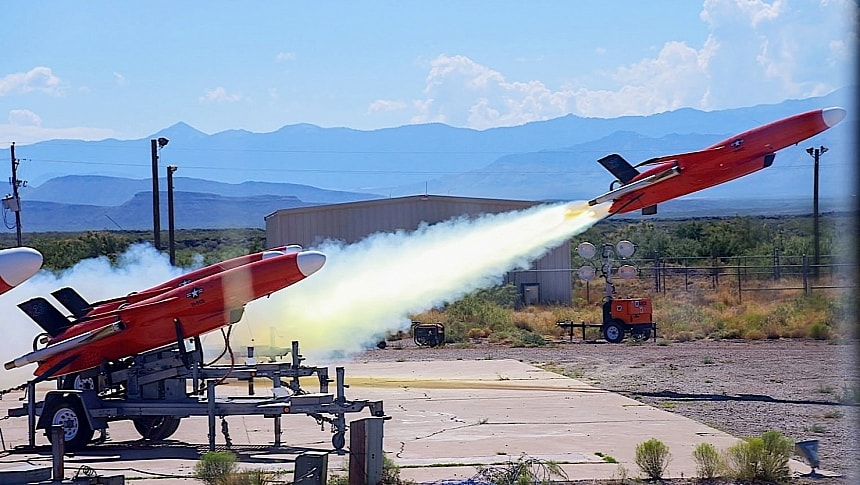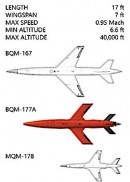Testing weapons is a complicated business and involves a lot of time and effort. That's because, although it may seem that way, weapons testing is about much more than just pointing them at a target and pressing the "fire” button.
Despite this, especially when it comes to the U.S. Navy and the U.S. Air Force (USAF), we often get to see great leaps being made in R&D. Yet, we almost always get to see a single side of the coin, that of the weapons doing what they were supposed to do.
It so happens that in some cases these branches of the military need a weapon to be used against a moving airborne target and not a stationary one somewhere on the ground or on the water. And this is where the aerial targets come in.
These are basically uncrewed aircraft of different shapes and sizes that can be used to mimic an enemy airplane, a missile, or a rocket. Technically speaking an aerial target is launched in one fashion or another with the sole purpose of it being destroyed during engagements.
Such contraptions have been around for some time but in many respects they are falling behind what the actual weapons of the actual enemy are capable of doing. Not to mention that their performance in the sky often depends on what controllers on the ground are telling them to do.
So, as enemy weapons and pilot skills evolve, so must the aerial targets the Navy is using for training and testing purposes. And this is where something called the Hivemind comes in.
We've talked about this system at length not long ago. Developed by a company called Shield AI, it is basically a computer mind that can work without being affected by the lack of remote operators or a GPS signal.
Hivemind does this by using an aircraft's sensors to create a map of its surroundings and navigate based on the data it gains this way. It can execute autonomous missions on its own, and does not require previous knowledge to make split-second decisions, making it highly adaptable to changing environments.
It's a piece of tech that was not sufficiently detailed for us, the civilian public, but managed to impress the military with its qualities. American armed forces and military contractors are already using it on some F-16s and a series of Kratos-made drones – in all, seven aerial platforms are equipped with the Hivemind brain.
An eight one was just announced this week. It's the Kratos BQM-177A, a Sub-Sonic Aerial Target (SSAT) used by the Navy to simulate air-to-air engagements. The aircraft is very capable from the factory, as it can fly at speeds close to that of sound and at altitudes between six and 40,000 feet (two to 12,200 meters), but the Hivemind will give it new capabilities.
The decision to integrate the AI with the unmanned aircraft was taken by the Naval Air Systems Command (NAVAIR) and it's meant to give the Kratos machine new capabilities. There is no mention made of when the integration will be complete, but judging by past experience it will probably not take more than a few months.
It so happens that in some cases these branches of the military need a weapon to be used against a moving airborne target and not a stationary one somewhere on the ground or on the water. And this is where the aerial targets come in.
These are basically uncrewed aircraft of different shapes and sizes that can be used to mimic an enemy airplane, a missile, or a rocket. Technically speaking an aerial target is launched in one fashion or another with the sole purpose of it being destroyed during engagements.
Such contraptions have been around for some time but in many respects they are falling behind what the actual weapons of the actual enemy are capable of doing. Not to mention that their performance in the sky often depends on what controllers on the ground are telling them to do.
So, as enemy weapons and pilot skills evolve, so must the aerial targets the Navy is using for training and testing purposes. And this is where something called the Hivemind comes in.
We've talked about this system at length not long ago. Developed by a company called Shield AI, it is basically a computer mind that can work without being affected by the lack of remote operators or a GPS signal.
Hivemind does this by using an aircraft's sensors to create a map of its surroundings and navigate based on the data it gains this way. It can execute autonomous missions on its own, and does not require previous knowledge to make split-second decisions, making it highly adaptable to changing environments.
It's a piece of tech that was not sufficiently detailed for us, the civilian public, but managed to impress the military with its qualities. American armed forces and military contractors are already using it on some F-16s and a series of Kratos-made drones – in all, seven aerial platforms are equipped with the Hivemind brain.
An eight one was just announced this week. It's the Kratos BQM-177A, a Sub-Sonic Aerial Target (SSAT) used by the Navy to simulate air-to-air engagements. The aircraft is very capable from the factory, as it can fly at speeds close to that of sound and at altitudes between six and 40,000 feet (two to 12,200 meters), but the Hivemind will give it new capabilities.
The decision to integrate the AI with the unmanned aircraft was taken by the Naval Air Systems Command (NAVAIR) and it's meant to give the Kratos machine new capabilities. There is no mention made of when the integration will be complete, but judging by past experience it will probably not take more than a few months.




















